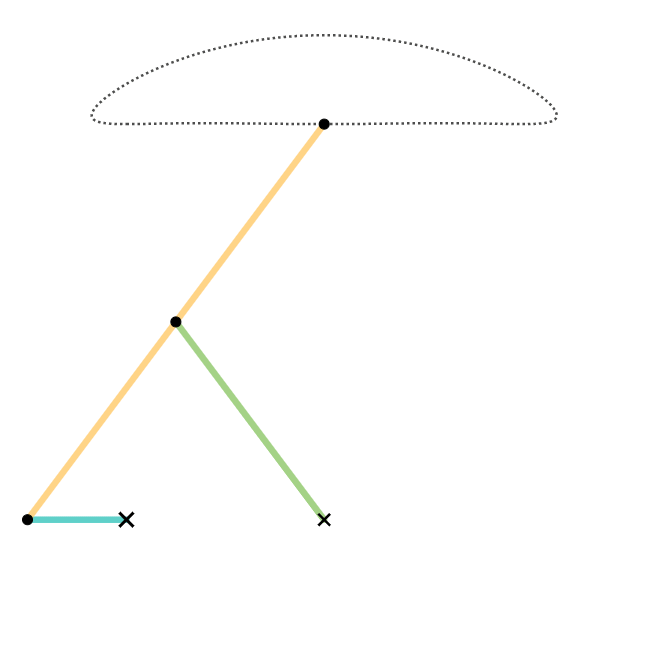|
Chebyshev Lambda Linkage
In kinematics, the Chebyshev Lambda Linkage is a four-bar linkage that converts rotational motion to approximate straight-line motion with approximate constant velocity. It is so-named because it looks like a lowercase Greek letter lambda (λ). The precise design trades off straightness, lack of acceleration, and the proportion of the driving rotation that is spent in the linear portion of the full curve. The example to the right spends over half of the cycle in the near straight portion. Coupler (link 3) point stays within 1% positional tolerance with intersecting the ideal straight line 6 times. The linkage was first shown in Paris on the Exposition Universelle (1878) as "The Plantigrade Machine". The Chebyshev Lambda Linkage is a cognate linkage of the Chebyshev linkage. The Chebyshev Lambda Linkage is used in vehicle suspension mechanisms, walking robots and rover wheel mechanisms. In 2004, a study completed as a Master of Science Thesis at Izmir Institute of Technology ... [...More Info...] [...Related Items...] OR: [Wikipedia] [Google] [Baidu] |
Cognate Linkage
In kinematics, cognate linkages are linkages that ensure the same coupler curve geometry or input-output relationship, while being dimensionally dissimilar. In case of four-bar linkage coupler cognates, the Roberts–Chebyshev Theorem, after Samuel Roberts and Pafnuty Chebyshev, Retrieved 2012-10-12 states that each coupler curve can be generated by three different four-bar linkages. These four-bar linkages can be constructed using similar triangles and parallelograms, and the Cayley diagram (named after ). Overconstrained mechanism ... [...More Info...] [...Related Items...] OR: [Wikipedia] [Google] [Baidu] |
Straight Line Mechanism
A straight-line mechanism is a mechanism that converts any type of rotary or angular motion to perfect or near-perfect straight-line motion, or ''vice-versa''. Straight-line motion is linear motion of definite length or "stroke", every forward stroke being followed by a return stroke, giving reciprocating motion. The first such mechanism, patented in 1784 by James Watt, produced approximate straight-line motion, referred to by Watt as parallel motion. Straight-line mechanisms are used in a variety of applications, such as engines, vehicle suspensions, walking robots, and rover wheels. History In the late eighteenth century, before the development of the planer and the milling machine, it was extremely difficult to machine straight, flat surfaces. During that era, much thought was given to the problem of attaining a straight-line motion, as this would allow the flat surfaces to be machined. To find a solution to the problem, the first straight line mechanism was devel ... [...More Info...] [...Related Items...] OR: [Wikipedia] [Google] [Baidu] |
Leg Mechanism
A leg mechanism (walking mechanism) is a mechanical system designed to provide a propulsive force by intermittent frictional contact with the ground. This is in contrast with wheels or continuous tracks which are intended to maintain continuous frictional contact with the ground. Mechanical legs are linkages that can have one or more actuators, and can perform simple planar or complex motion. Compared to a wheel, a leg mechanism is potentially better fitted to uneven terrain, as it can step over obstacles. An early design for a leg mechanism called the ''Plantigrade Machine'' by Pafnuty Chebyshev was shown at the Exposition Universelle (1878). The original engravings for this leg mechanism are available. The design of the leg mechanism for the Ohio State Adaptive Suspension Vehicle (ASV) is presented in the 1988 book ''Machines that Walk''. In 1996, W-B. Shieh presented a design methodology for leg mechanisms. The artwork of Theo Jansen, see Jansen's linkage, has been ... [...More Info...] [...Related Items...] OR: [Wikipedia] [Google] [Baidu] |
Hoeckens Linkage
In kinematics, the Hoecken linkage (named for Karl Hoecken) is a four-bar linkage that converts rotational motion to approximate straight-line motion. The Hoecken linkage is a cognate linkage of the Chebyshev linkage and Chebyshev's Lambda Mechanism. The linkage was first published in 1926. A generalization of the Hoecken linkage is Wittgenstein's rod. See also *Chebyshev linkage and Chebyshev lambda linkage, linkages that produce a very similar locus without the need of a sliding joint. *Straight line mechanism *Four-bar linkage In the study of mechanisms, a four-bar linkage, also called a four-bar, is the simplest closed- chain movable linkage. It consists of four bodies, called ''bars'' or ''links'', connected in a loop by four joints. Generally, the joints are configu ... References External links Straight line mechanisms Linkages (mechanical) {{technology-stub ... [...More Info...] [...Related Items...] OR: [Wikipedia] [Google] [Baidu] |
Cognate Linkage
In kinematics, cognate linkages are linkages that ensure the same coupler curve geometry or input-output relationship, while being dimensionally dissimilar. In case of four-bar linkage coupler cognates, the Roberts–Chebyshev Theorem, after Samuel Roberts and Pafnuty Chebyshev, Retrieved 2012-10-12 states that each coupler curve can be generated by three different four-bar linkages. These four-bar linkages can be constructed using similar triangles and parallelograms, and the Cayley diagram (named after ). Overconstrained mechanism ... [...More Info...] [...Related Items...] OR: [Wikipedia] [Google] [Baidu] |





